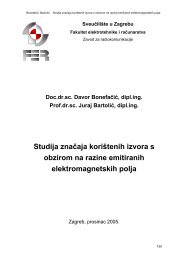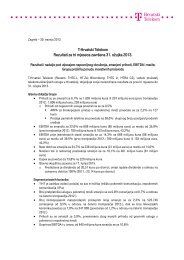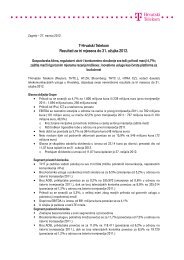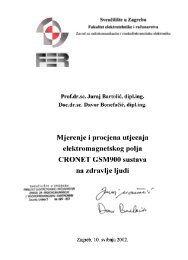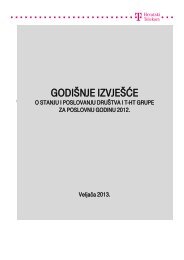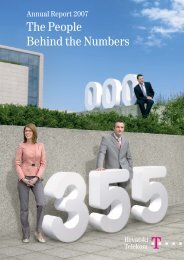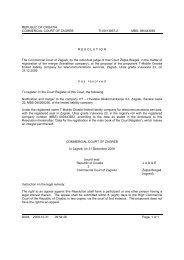Annual Report 2011 - T-Hrvatski Telekom
Annual Report 2011 - T-Hrvatski Telekom
Annual Report 2011 - T-Hrvatski Telekom
You also want an ePaper? Increase the reach of your titles
YUMPU automatically turns print PDFs into web optimized ePapers that Google loves.
87<br />
k) Leases<br />
Leases in which a significant portion of the risks and<br />
rewards of ownership are retained by the lessor are<br />
classified as operating leases. Payments made under<br />
operating leases (net of any incentives received<br />
from the lessor) are charged to the statement of<br />
comprehensive income on a straight-line basis over<br />
the period of the lease.<br />
Leases of property, plant and equipment where the<br />
Group has substantially all the risks and rewards of<br />
ownership are classified as finance lease. Finance<br />
leases are capitalised at the lease’s commencement<br />
at the lower of the fair value of the leased property<br />
and the present value of the minimum lease<br />
payments. Each lease payment is allocated between<br />
the liability and finance charge. The corresponding<br />
rental obligations, net of finance charges, are<br />
included in borrowings. The interest element of<br />
the finance cost is charged to the statement of<br />
comprehensive income over the lease period so as<br />
to produce constant periodic rate of interest on the<br />
remaining balance of the liability for each period.<br />
The property, plant and equipment acquired under<br />
finance lease is depreciated over the shorter of the<br />
useful life of the assets and the lease term.<br />
l) Taxation<br />
The income tax charge is based on profit for the<br />
year and includes deferred taxes. Deferred taxes are<br />
calculated using the liability method.<br />
Deferred income taxes reflect the net tax effects<br />
of temporary differences between the carrying<br />
amounts of assets and liabilities for financial reporting<br />
purposes and the amounts used for income tax<br />
purposes at the reporting date.<br />
Deferred tax is determined using income tax rates that<br />
have been enacted or substantially enacted by the<br />
financial statement date and are expected to apply<br />
when the related deferred tax asset is realized or the<br />
deferred tax liability is settled.<br />
expects, at the reporting date, to recover or settle the<br />
carrying amount of its assets and liabilities.<br />
Deferred tax assets are recognized to the extent that<br />
it is probable that future taxable profit (or reversing<br />
deferred tax liabilities) will be available against which<br />
the temporary differences can be utilized.<br />
Deferred tax assets and liabilities are not discounted<br />
and are classified as non-current assets and liabilities<br />
in the statement of financial position. Deferred<br />
tax assets are recognized when it is probable that<br />
sufficient taxable profits will be available against<br />
which the deferred tax assets can be utilised.<br />
Current tax and deferred tax are charged or credited<br />
in other comprehensive income if the tax relates to<br />
items that are credited or charged, in the same or a<br />
different period in other comprehensive income.<br />
m) Employee benefit obligations<br />
The Group provides other long-term employee<br />
benefits (see Note 19). These benefits include<br />
retirement and jubilee (length of service) payments,<br />
and are determined using a projected unit credit<br />
method. The projected unit credit method considers<br />
each period of service as giving rise to an additional<br />
unit of benefit entitlement and measures each unit<br />
separately to build up the final obligation.<br />
Past service costs are recognized in other<br />
comprehensive income immediately in the period in<br />
which they occur. Gains or losses on the curtailment<br />
or settlement of benefit plans are recognized when<br />
the curtailment or settlement occurs. The benefit<br />
obligation is measured at the present value of<br />
estimated future cash flows using a discount rate that<br />
is similar to the interest rate on government bonds<br />
where the currency and terms of the government<br />
bonds are consistent with the currency and estimated<br />
terms of the benefit obligation. Gains and losses<br />
resulting from changes in actuarial assumptions are<br />
recognized in other comprehensive income in the<br />
period in which they occur.<br />
Consolidated financial statements<br />
The measurement of deferred tax liabilities and<br />
deferred tax assets reflects the tax consequences that<br />
would arise from the manner in which the enterprise<br />
The Group provides death in service short term<br />
benefits which are recognized as an expense of the<br />
period in which it incurred.



